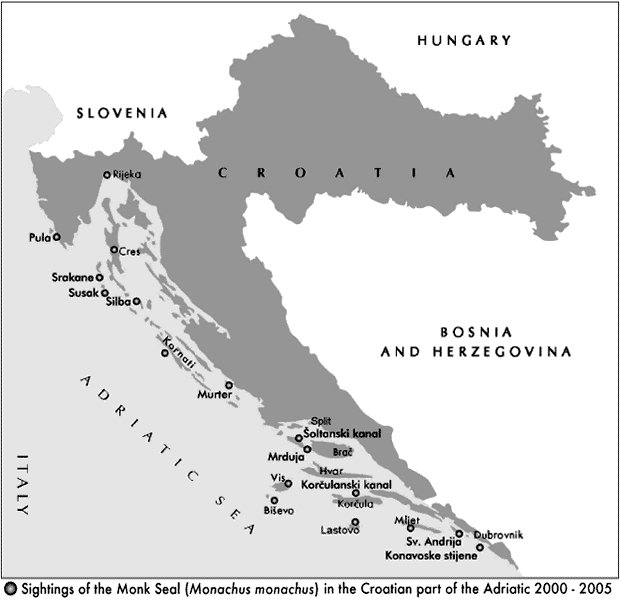Monk seal (Monachus monachus) sightings in the Croatian part of the Adriatic with a special reference to the population of open-sea islands
J. Antolović, M. Antolović, N. Antolović, B. Furlan,
Lj. Adamić-Antolović, R. Antolović and I. Čok
The Mediterranean Monk Seal Group, The Association for the Research and Protection of Nature,
Krešimirov trg 15, HR-10000 Zagreb, Croatia
Abstract
The Mediterranean Monk Seal (Monachus monachus) is one of the world’s most endangered mammals. Our research was aimed at obtaining information from the local fishermen in the Croatian part of the Adriatic Sea and investigating its habitats in these areas. We have investigated 51 habitats in the Adriatic Sea. Legislative measures for the protection of the Mediterranean monk seal were not sufficiently effective to enable preservation of this species in the Adriatic sea.
Introduction
The monk seal (Monachus monachus, Hermann 1779) belongs to the order (Pinnipedia), family (Phocidae), genus (Monachus). It lives in groups around the Mediterranean and the Atlantic along the coast of Mauritania, Western Sahara and Morocco. The total population is about 350 individuals in smaller isolated and endangered groups, whose biology is still not very well-known (Sergeant et al. 1978). Formerly, a population of 64 individuals was estimated to live in the Adriatic, but today this number has significantly decreased (Jardas & Draganović 1987). Habitat research (1987-1997) gathering sightings of Mediterranean monk seals at former/present habitats/caves, as well as conversations with fishermen of the Adriatic open sea islands, indicates that this species still lives in that area (Antolović et al. 1997).
Aim
The aim of the six-year (2000 - 2005) research was to collect data on sightings of the monk seal in the Croatian part of the Adriatic (see map), visit caves/habitats and obtain insights into the attitude of interest groups, in order to encourage cooperation.
Materials and methods
The procedure used was a survey/questionnaire, completed during interviews with fishermen and other inhabitants of the Central and South Adriatic. The collected data (representing 1020 participants) and their analyses, enable an assessment of attitudes towards the protection of the species, as well as an understanding of the behaviour of an individual during a seal sighting encounter.

Results
Based on systematic research of habitat (51 caves), and also reported shootings of seals, it has been established that the species does inhabit the open sea islands of the Adriatic (Antolovic´ 2001). Reports of sightings of individuals were in the area of the whole Croatian part of the Adriatic (107 sightings). From the analyses of reports, the species has mostly been observed in spring and summer months and rarely in autumn and winter months. The size (from 1m to 2.60m) and colour (grey and brown) of observed individuals varied.
Conclusion
By educational methods which incorporate lectures, and distributing questionnaires on sightings of the monk seal, the public has become interested in reporting their sightings. Simultaneous sightings in several areas indicate that a smaller population of the monk seal lives in the Adriatic in two colonies of about 6-8 individuals. Material evidence consists of photographs of individuals recorded in various areas of the Croatian part of the Adriatic. Legal regulations are inefficient and a greater possibility for the survival of the species lies in establishing specially protected areas at the open sea islands of the Adriatic.
References
Antolović, J., N. Skakelja and Đ. Huber. 1997. Status of the Mediterranean Monk Seal (Monachus monachus Hermann) in the Croatian part of the Adriatic sea with special attention to population in the Vis archipelago (The survey analyses). Proceedings of abstracts. The sixth Congress of Croatian Biologists. Croatian Biological Society, Zagreb, 268: 362-363.
Antolović, J., A. Vaso, L. Kashta, V. Shutina, S. Anagnosti, S. Bogdanović, Lj. Adamić and N. Antolović. 2001. Protection of the Mediterranean Monk Seal (Monachus monachus) and its habitats. Rapport Du 36e Congrés de la Commission Internationale pour l’Exploration Scientifique de la mer Méditerranée. Monte Carlo (Monaco), 36-230.
Jardas, I. and E. Draganović. 1987. Rasprostranjenost, brojnost i zaštita populacije sredozemne medvjedice (Monachus monachus Hermann, 1779) s posebnim osvrtom na Jadransko more. Akademija nauka i umjetnosti Bosne i Hercegovine, 83: 81-94.
Sergeant, D., K. Ronald, J. Boulva and F. Berkes. 1978. The Recent Status of Monachus monachus, the Mediterranean Monk Seal, Biol. Conserv., England, 14: 259-287.
These findings were presented at the 9th Croatian Biological Congress, held in September 2006 in Rovinj.
|



